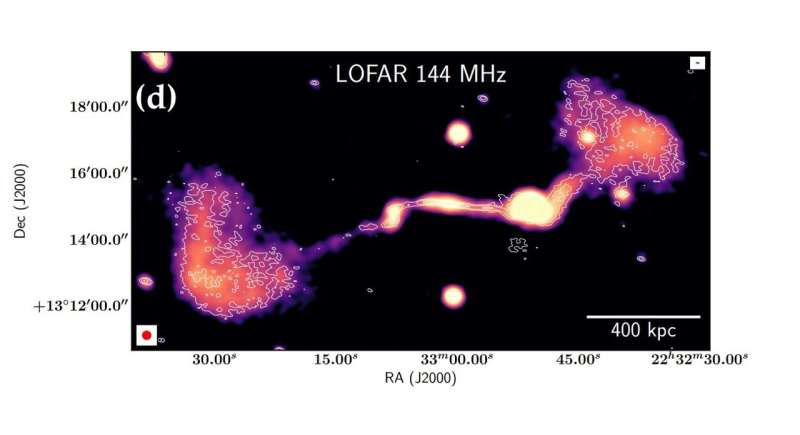October 10, 2022 report
Peculiar giant radio galaxy GRG-J223301+131502 investigated by researchers

An international team of astronomers has conducted radio and optical observations of a peculiar giant radio galaxy known as GRG-J223301+131502. Results of the observational campaign shed more light on the properties of this galaxy and have unveiled its exceptional jet structure. The findings are reported in a paper published September 26 on arXiv.org.
The so-called giant radio galaxies (GRGs) are radio galaxies with an overall projected linear length exceeding at least 2.3 million light years. They are rare objects grown in low-density environments. In general, GRGs are important for astronomers to study the formation and the evolution of radio sources.
So far, about a thousand GRGs have been detected, out of which only ten exceed 10 million light years in size. The largest one is J1420-0545—with a projected proper length of approximately 16 million light years. Therefore, GRGs and also the rest of the megaparsec-scale radio galaxies are assumed to be the largest single-galaxy–induced phenomena in the universe.
At a redshift of 0.093, GRG-J223301+131502 (GRG-J2233+1315 for short) is a giant radio galaxy first identified in 2017 as part of the Search and Analysis of GRGs with Associated Nuclei (SAGAN) project. It has a total projected linear size of nearly 5.57 million light years and is hosted by SDSSJ223301.30+131502.5—an S0-a type galaxy exhibiting a big diffuse stellar halo.
Previous studies of GRG-J2233+1315 have found that this galaxy is residing in a dense cluster environment, which is in contrast to the current theories that GRGs usually reside in a sparse environment. Therefore, in order to verify this, a group of astronomers led by Pratik Dabhade of Sorbonne University in Paris, France, performed deep multi-frequency radio observations of GRG-J2233+1315 with the Giant Metrewave Radio Telescope (GMRT) and Low-Frequency Array (LOFAR), as well as spectroscopic observations using the William Herschel Telescope (WHT).
The deep and high-resolution radio images disclosed an enormous jet, about 772,000 light years in size, emanating from the radio core of GRG-J2233+1315 and leading to a "kink" extending some 326,000 light years. The images also show that the galaxy exhibits lobes without any prominent hotspots and closely resembles a barbell, hence the researchers dubbed GRG-J2233+1315 the Barbell GRG. These detected lobes turned out to have magnetic field strength of about 5 µG and spectral ages between 110 and 200 million years.
The observations found that the Barbell GRG has a redshift of approximately 0.099 and that its linear size is larger than previously thought—almost 6 million light years. The results indicate that the host galaxy has a relatively low star formation rate—at a level of about 0.001 solar masses per year.
Summing up the results, the authors of the paper underlined the importance of their findings for future studies.
"The discovery of the ∼ 100 kpc 'kink' structure from our study provides a unique opportunity for testing various MHD [magnetohydrodynamic] models on large scales.... This GRG with two-sided, large-scale jets with a kink and diffuse outer lobes residing in a cluster environment, provides an opportunity of exploring the structure and growth of GRGs in different environments," the researchers concluded.
More information: Pratik Dabhade et al, Barbell shaped giant radio galaxy with ~100 kpc kink in the jet. arXiv:2209.13059v1 [astro-ph.GA],
© 2022 Science X Network




















